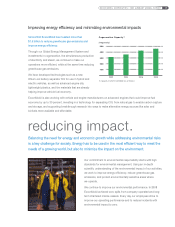Exxon 2008 Annual Report Download - page 16
Download and view the complete annual report
Please find page 16 of the 2008 Exxon annual report below. You can navigate through the pages in the report by either clicking on the pages listed below, or by using the keyword search tool below to find specific information within the annual report.
The Outlook for Energy –
A View to 2030
Energy – in all its forms – is critical to economic growth,
development, and social welfare. Meeting the projected
increase in energy demand to support growing
populations and expanding economies poses many
challenges, and will require an integrated set of solutions.
To help us prepare for the future energy marketplace,
each year ExxonMobil develops The Outlook for Energy,
a broad, in-depth look at the long-term global trends for
energy demand and supply, and their impact on carbon
dioxide (CO2) emissions. The results of this comprehensive
study provide a foundation for ExxonMobil’s business
planning and are shared publicly to help build under-
standing of the world’s energy needs and challenges.
The Link Between Economic Growth and Energy
Energy and economic growth have long been entwined: The
availability of energy supports long-term economic and social
progress; economic growth drives increased energy usage.
Despite current economic conditions, global economic
output, as measured by Gross Domestic Product (GDP),
is expected to increase by close to 3 percent on average
annually through 2030.
Importantly the global economy is becoming more energy
efficient. From 1980 to 2005, “energy intensity” – the amount
of energy used per unit of economic output – improved by
1 percent per year on average. Going forward to 2030, we
expect the rate of improvement will be 70-percent faster
than in the past.
Even with significant energy intensity improvements, global
energy demand is expected to increase approximately
35 percent from 2005 to 2030. The majority of new energy
demand will come from Asia Pacific, reflecting strong
EricWhetstone•WhetstoneDesignLab
office:214-788-6336•cell:
EDITOR
DavidBailey•InvestorRelations
ExxonMobilCorporation,Irving,TX
office:972-444-1135•cell:214-478-9189
CarolZuber-Mallison•ZMGraphics
studio/cell:214-906-4162•fax:817-924-7784
Usage:ExclusiverightswithinExxonMobil
(c)2009,ZMGraphicsImagecannotberesold
ATTENTION:OWNER
Datalistisusedtodrivetheblackand
templateforthecolorchart.Barsand
linesarecutandpastedfromtheblack
andwhitetemplateandarehighly
accurate.However,thecolorchartis
NOTlinkedtothedatabaseandisNOT
“driven”bythedata;itisapieceof
artworkbuiiltbyahuman.Therefore,the
editorneedstothoroughlyproofthefinal
artwork,notJUSTthedatalist.
VERSION
APPROVEDBY
Onderdonk/Corporate
Planning&Development
Feb.19,2009
FILEINFO
LASTFILECHANGEMADEBY
18A08XOMF-
WorldPop.ai
Carol James Bill
INF&OONPAGE
INSARONPAGE
Note:
Includeslinkfile
ISIN
SARandF&O
Note:Populationdataisinmillions,
chartisinbillions
20301980 2005
WorldwideEconomicsandEnergy
(billions of people)
10
8
6
4
2
Population
AnnualGrowth
2005–2030
Average 0.9%
economic growth. Oil, natural gas, and coal will remain the
predominant energy sources through 2030, but renewable
sources such as wind, solar, and biofuels will increase rapidly.
Transportation Demand Driven by Developing Economies
Transportation provides perhaps the most visible use of
energy. Moving people and goods requires tremendous
amounts of energy worldwide, and that will not change
in the foreseeable future. In fact energy demand for
transportation is expected to increase by 40 percent from
2005 to 2030.
The global growth in transportation demand will be met
primarily by oil, which is expected to provide almost
95 percent of all transportation fuel in 2030.
Electricity Demand Increases Need for Power Generation
As economies grow and access increases, global demand
for electricity is projected to increase 75 percent by 2030
versus 2005.
Consistent with this projection, energy for power generation
is expected to remain the largest and fastest growing
segment of global demand, driven in large part by strong
growth in Asia Pacific.
Meeting the expected worldwide growth in power demand
will require a diverse set of energy sources. Today coal is
dominant and will retain the largest share globally through
2030; however, natural gas, nuclear, and renewables will all
gain market share.
Worldwide Liquids Demand
Liquid fuels derived from oil, condensates, and natural gas
liquids provide the largest share of energy supply today, due
to their affordability, wide availability, and ease of transport.
By 2030, global demand for liquids is expected to grow to
approximately 108 million oil-equivalent barrels per day or
close to 30 percent more than in 2005.
EricWhetstone•WhetstoneDesignLab
office:214-788-6336•cell:
EDITOR
DavidBailey•InvestorRelations
ExxonMobilCorporation,Irving,TX
office:972-444-1135•cell:214-478-9189
CarolZuber-Mallison•ZMGraphics
studio/cell:214-906-4162•fax:817-924-7784
Usage:ExclusiverightswithinExxonMobil
(c)2009,ZMGraphicsImagecannotberesold
ATTENTION:OWNER
Datalistisusedtodrivetheblackand
templateforthecolorchart.Barsand
linesarecutandpastedfromtheblack
andwhitetemplateandarehighly
accurate.However,thecolorchartis
NOTlinkedtothedatabaseandisNOT
“driven”bythedata;itisapieceof
artworkbuiiltbyahuman.Therefore,the
editorneedstothoroughlyproofthefinal
artwork,notJUSTthedatalist.
VERSION
APPROVEDBY
Onderdonk/Corporate
Planning&Development
Feb.19,2009
FILEINFO
LASTFILECHANGEMADEBY
18B08XOMF-
WorldGDP.ai
Carol James Bill
INF&OONPAGE
INSARONPAGE
Note:
18B
S14B
Includeslinkfile
ISIN
SARandF&O
Note:GDPdataisinbillions,
chartistrillions
20301980 2005
WorldwideEconomicsandEnergy
(trillions of dollars, 2005 dollars)
100
80
60
40
20
Gross Domestic Product
AnnualGrowth
2005–2030
Average 3.0%
EricWhetstone•WhetstoneDesignLab
office:214-788-6336•cell:
EDITOR
DavidBailey•InvestorRelations
ExxonMobilCorporation,Irving,TX
office:972-444-1135•cell:214-478-9189
CarolZuber-Mallison•ZMGraphics
studio/cell:214-906-4162•fax:817-924-7784
Usage:ExclusiverightswithinExxonMobil
(c)2009,ZMGraphicsImagecannotberesold
ATTENTION:OWNER
Datalistisusedtodrivetheblackand
templateforthecolorchart.Barsand
linesarecutandpastedfromtheblack
andwhitetemplateandarehighly
accurate.However,thecolorchartis
NOTlinkedtothedatabaseandisNOT
“driven”bythedata;itisapieceof
artworkbuiiltbyahuman.Therefore,the
editorneedstothoroughlyproofthefinal
artwork,notJUSTthedatalist.
VERSION
APPROVEDBY
Onderdonk/Corporate
Planning&Development
Feb.20,200912:52am
FILEINFO
LASTFILECHANGEMADEBY
18C08XOMF-
WorldEnergy.ai
Carol James Bill
INF&OONPAGE
INSARONPAGE
Note:
ISIN
SARandF&O
Samedata
indifferentdesign
AlsoinSARasdifferent
designonS06A
20301980 2005
WorldwideEconomicsandEnergy
350
300
250
200
150
100
50
Energy Demand
(millions of oil-equivalent barrels per day)
AnnualGrowth
2005–2030
Average 1.2%
E X X O N M O B I L C O R P O R A T I O N • 2 0 0 8 S U M M A R Y A N N U A L R E P O R T
14
























